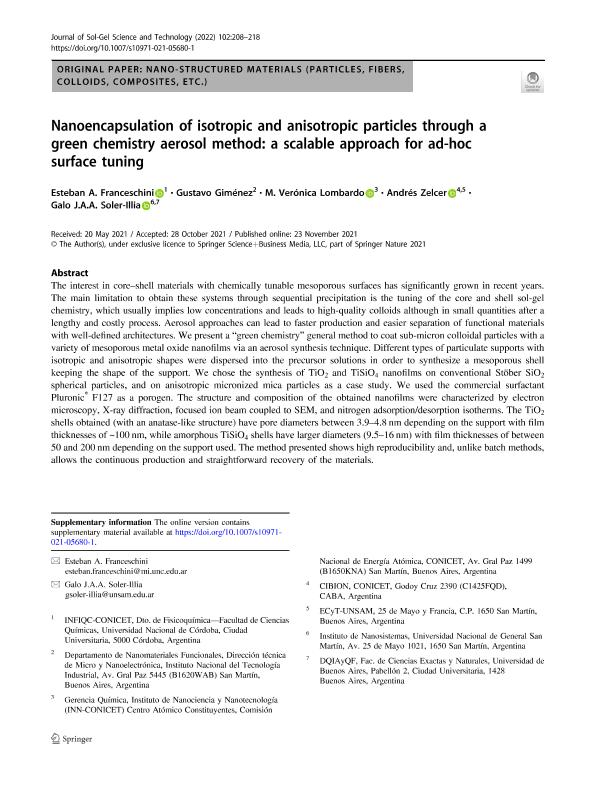Artículo
Nanoencapsulation of isotropic and anisotropic particles through a green chemistry aerosol method: a scalable approach for ad-hoc surface tuning
Franceschini, Esteban Andrés ; Giménez, Gustavo; Lombardo, Maria Veronica
; Giménez, Gustavo; Lombardo, Maria Veronica ; Zelcer, Andrés
; Zelcer, Andrés ; Soler Illia, Galo Juan de Avila Arturo
; Soler Illia, Galo Juan de Avila Arturo
 ; Giménez, Gustavo; Lombardo, Maria Veronica
; Giménez, Gustavo; Lombardo, Maria Veronica ; Zelcer, Andrés
; Zelcer, Andrés ; Soler Illia, Galo Juan de Avila Arturo
; Soler Illia, Galo Juan de Avila Arturo
Fecha de publicación:
11/2021
Editorial:
Springer
Revista:
Journal of Sol-Gel Science and Technology
ISSN:
0928-0707
Idioma:
Inglés
Tipo de recurso:
Artículo publicado
Clasificación temática:
Resumen
The interest in core–shell materials with chemically tunable mesoporous surfaces has significantly grown in recent years. The main limitation to obtain these systems through sequential precipitation is the tuning of the core and shell sol-gel chemistry, which usually implies low concentrations and leads to high-quality colloids although in small quantities after a lengthy and costly process. Aerosol approaches can lead to faster production and easier separation of functional materials with well-defined architectures. We present a “green chemistry” general method to coat sub-micron colloidal particles with a variety of mesoporous metal oxide nanofilms via an aerosol synthesis technique. Different types of particulate supports with isotropic and anisotropic shapes were dispersed into the precursor solutions in order to synthesize a mesoporous shell keeping the shape of the support. We chose the synthesis of TiO2 and TiSiO4 nanofilms on conventional Stöber SiO2 spherical particles, and on anisotropic micronized mica particles as a case study. We used the commercial surfactant Pluronic® F127 as a porogen. The structure and composition of the obtained nanofilms were characterized by electron microscopy, X-ray diffraction, focused ion beam coupled to SEM, and nitrogen adsorption/desorption isotherms. The TiO2 shells obtained (with an anatase-like structure) have pore diameters between 3.9–4.8 nm depending on the support with film thicknesses of ~100 nm, while amorphous TiSiO4 shells have larger diameters (9.5–16 nm) with film thicknesses of between 50 and 200 nm depending on the support used. The method presented shows high reproducibility and, unlike batch methods, allows the continuous production and straightforward recovery of the materials.
Palabras clave:
AEROSOL PROCESSING
,
CORE–SHELL
,
MESOPOROUS MATERIALS
,
SILICA
,
TITANIA
Archivos asociados
Licencia
Identificadores
Colecciones
Articulos(CIBION)
Articulos de CENTRO DE INVESTIGACIONES EN BIONANOCIENCIAS "ELIZABETH JARES ERIJMAN"
Articulos de CENTRO DE INVESTIGACIONES EN BIONANOCIENCIAS "ELIZABETH JARES ERIJMAN"
Articulos(INFIQC)
Articulos de INST.DE INVESTIGACIONES EN FISICO- QUIMICA DE CORDOBA
Articulos de INST.DE INVESTIGACIONES EN FISICO- QUIMICA DE CORDOBA
Articulos(UE-INN)
Articulos de UNIDAD EJECUTORA INSTITUTO DE NANOCIENCIA Y NANOTECNOLOGIA
Articulos de UNIDAD EJECUTORA INSTITUTO DE NANOCIENCIA Y NANOTECNOLOGIA
Citación
Franceschini, Esteban Andrés; Giménez, Gustavo; Lombardo, Maria Veronica; Zelcer, Andrés; Soler Illia, Galo Juan de Avila Arturo; Nanoencapsulation of isotropic and anisotropic particles through a green chemistry aerosol method: a scalable approach for ad-hoc surface tuning; Springer; Journal of Sol-Gel Science and Technology; 102; 1; 11-2021; 208-218
Compartir
Altmétricas



